Knitting a sweater is always a very rewarding project. Whether you’re brand new to the knitting game and knitting your first ever or you’re an experienced knitter looking for a new and exciting inspiration, this guide will cover everything you need to know about how to knit a sweater. From choosing the right materials and understanding basic techniques to exploring various patterns, this post will help you on your knitting journey.
How to Knit a Sweater
When knitting a sweater there’s a couple of essential steps that are required to master the project. So if you’re a beginner a bit of practice and patience is important. Understanding these basics will help build a solid foundation for your project.
Choosing Your Yarn and Needles
The type of yarn and needle size you select can significantly impact the outcome of your sweater. In all the patterns they will recommend the yarn and needle size required, it is important to follow these recommendations, especially as a beginner. Here are some things to remember:
Yarn weight
Sweaters can be knitted in various yarn weights, from lightweight for summer tops to bulky for warm winter garments. Common weights include fingering, DK, worsted, and chunky.
Fiber Content
Wool is warm and breathable, cotton is cool and lightweight, and blends can offer the best of both worlds. Consider the season and occasion for which you are knitting the sweater.
Needle Size
The needle size should correspond to the yarn weight. Check the yarn label for recommended needle sizes. Circular needles are often used for sweaters, especially when working in the round.
Sweater Construction
Sweaters can be constructed in several ways, and choosing the right method can depend on your experience level and personal preference.
Top-Down
This method starts at the neckline and works downwards. It allows you to try on the sweater as you go, making it easier to adjust the fit to your body. These types of sweaters are definitely becoming more and more popular and are seen in newer patterns.
Bottom-Up
This traditional method begins at the hem and works upwards. Pieces are often knitted flat and then seamed together. This makes it more difficult to try on throughout the process.
Seamless
Using techniques like circular knitting, seamless sweaters avoid the need for sewing pieces
together, resulting in a smooth finish.
Techniques for Knitting a Sweater
To knit a sweater successfully, you’ll need to master a few basic techniques. These include casting on, knitting in the round, shaping (increases and decreases), and binding off.
Casting on
Casting on is the first step in any knitting project. There are various methods, but the long-tail cast-on is a popular choice for its versatility and stretch.
Knitting in the round
Many sweater patterns, especially those for seamless sweaters, require knitting in the round. This technique uses circular or double-pointed needles to create a continuous tube of fabric.
Shaping: Increases and Decreases
Shaping is crucial for creating a well-fitting sweater. Increases add stitches to widen the fabric, while decreases remove stitches to narrow it. These techniques are often used for shaping the sleeves, neckline, and waist. There are many different techniques to increasing and decreasing stitches but here is an example of each.
Increase:
Decrease:
Binding Off
Binding off secures the stitches and finishes the edge of your knitting. A stretchy bind-off is recommended for edges that need to stretch, like the neckline or cuffs.
Tips for Knitting a Sweater
Here are some tips to ensure your sweater knitting project goes smoothly:
Swatch for Gauge
Knitting a swatch is essential to ensure your sweater will fit correctly. Follow the pattern’s recommended gauge and adjust your needle size if necessary.
Measure Properly
Take accurate body measurements and compare them to the pattern’s size chart. Consider the ease (the difference between your measurements and the garment’s measurements) to achieve the desired fit.
Read the Pattern Thoroughly
Before starting, read through the entire pattern to understand the construction and any special techniques required, that way you won’t be surprised by any unknown techniques along the way.
Keep Notes
As you knit, keep notes on any modifications or adjustments you make. This will help you if you knit the pattern again or need to troubleshoot any issues. Use Knit&Note’s project view and notes to help with this!
Easy Knit Sweater Patterns
For beginners or those looking for a quick project, easy knit sweater patterns are the perfect choice. These patterns often use simple stitches and straightforward construction methods.
Raglan Sweaters
Raglan sweaters are knitted in the round from the top down, with the sleeves and body worked together. This seamless construction is easy to follow and provides a comfortable fit. This is definitely a great construction for beginners who are just getting started.
Simple Stockinette Sweaters
A basic stockinette stitch sweater is a great project for beginners. The body is usually worked in one piece with minimal shaping, making it a straightforward and relaxing knit.
Chunky Sweater Knitting Patterns
Chunky sweaters are not only warm and cozy but also quick to knit due to the thick yarn and large needles. These patterns are perfect for creating a statement piece in a short amount of time, and also a light and breezy piece for colder summer nights.
Sweater Knitting Pattern Inspiration
Finding the right pattern is key to a successful sweater knitting project. Here are some popular types of sweater knitting patterns to inspire your next project. These are all available in the Knit&Note pattern library!
First time sweater
It’s in the name, this is the perfect sweater to knit as your first ever one, The sweater is worked bottom up with two strands of yarn held together. This is a rather chunky sweater on a size 9 mm needle, making it a quick knit. This sweater is super beginner friendly, easy to follow and such a fun and quick project.
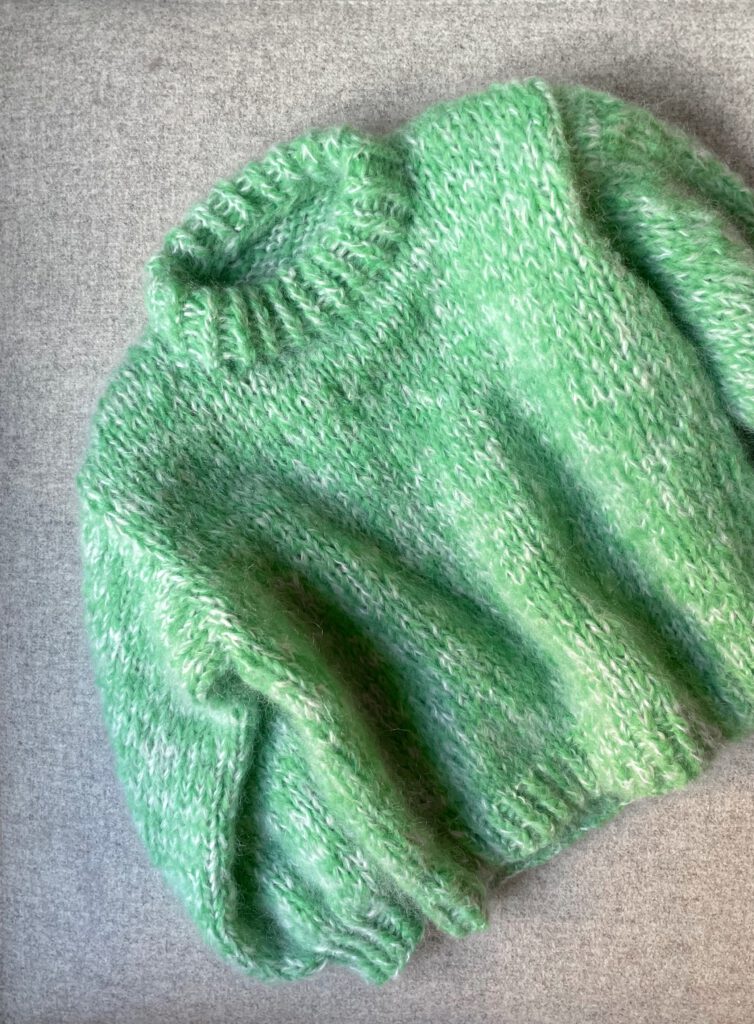
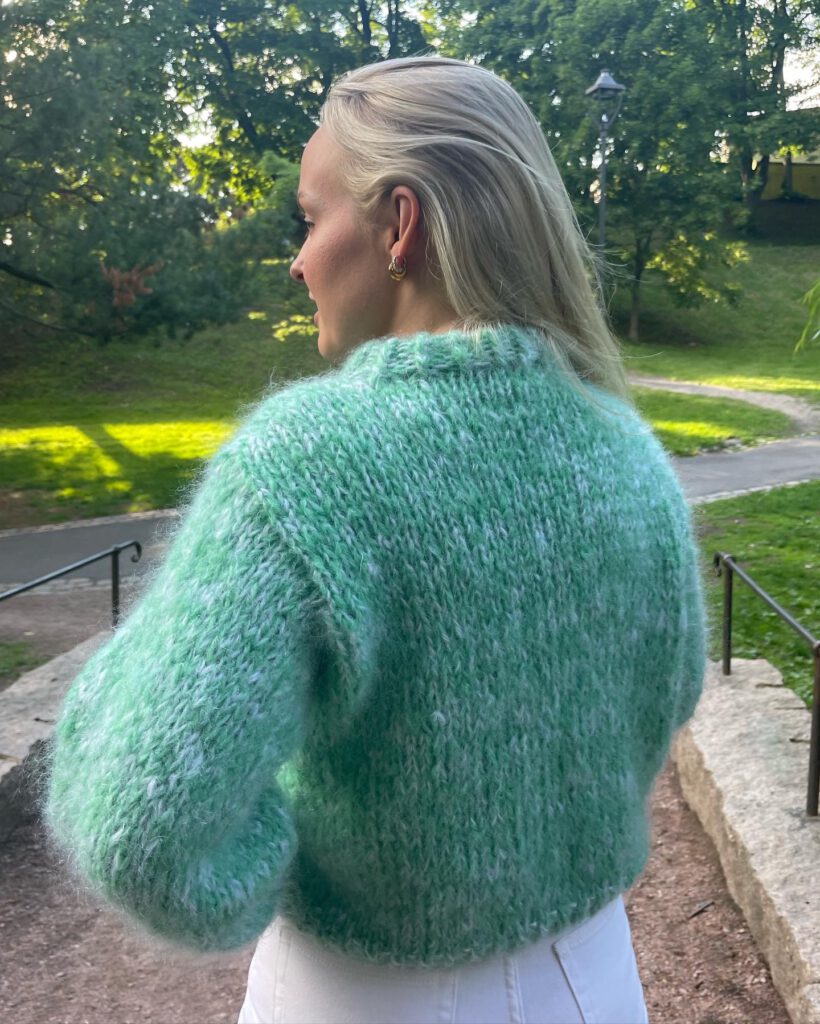
Scandi Sweater
Klin Coco’s is known for her chunky and fluffy knits, and this isn’t an exception. The Scandi Sweater is knitted on a size 12 needle making it the perfect beginner-friendly and quick knit sweater. This lightweight and soft mohair sweater can be styled for everyday wear and parties, and is suitable in both summer and winter. This easy sweater is the perfect beginner project.
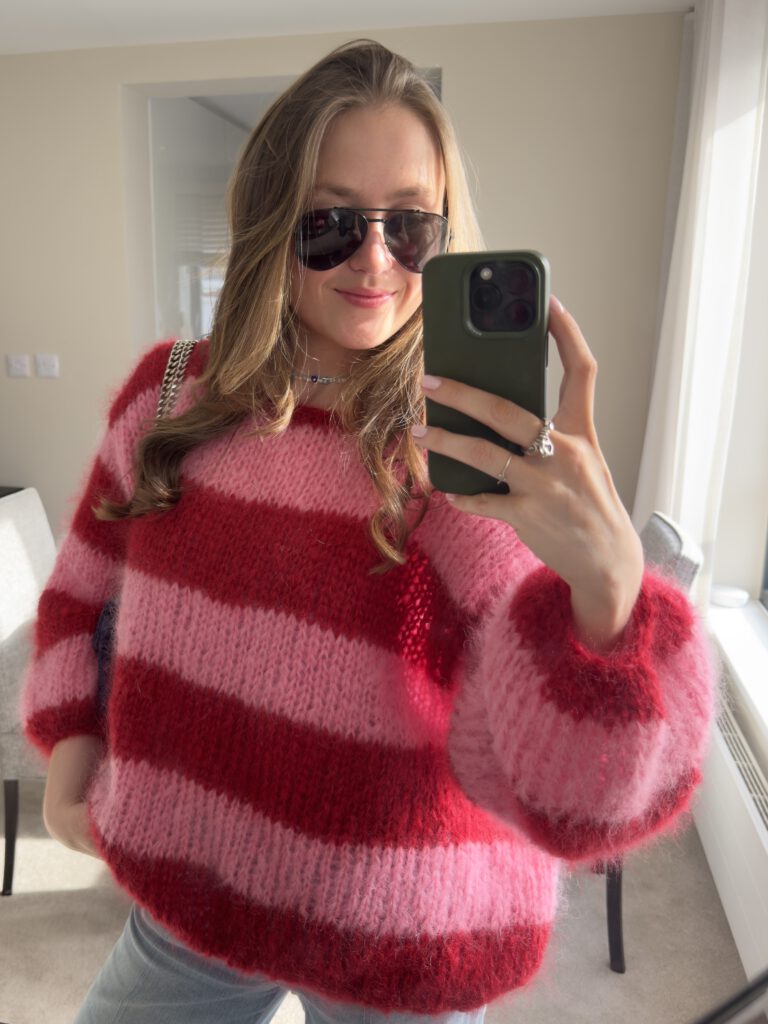
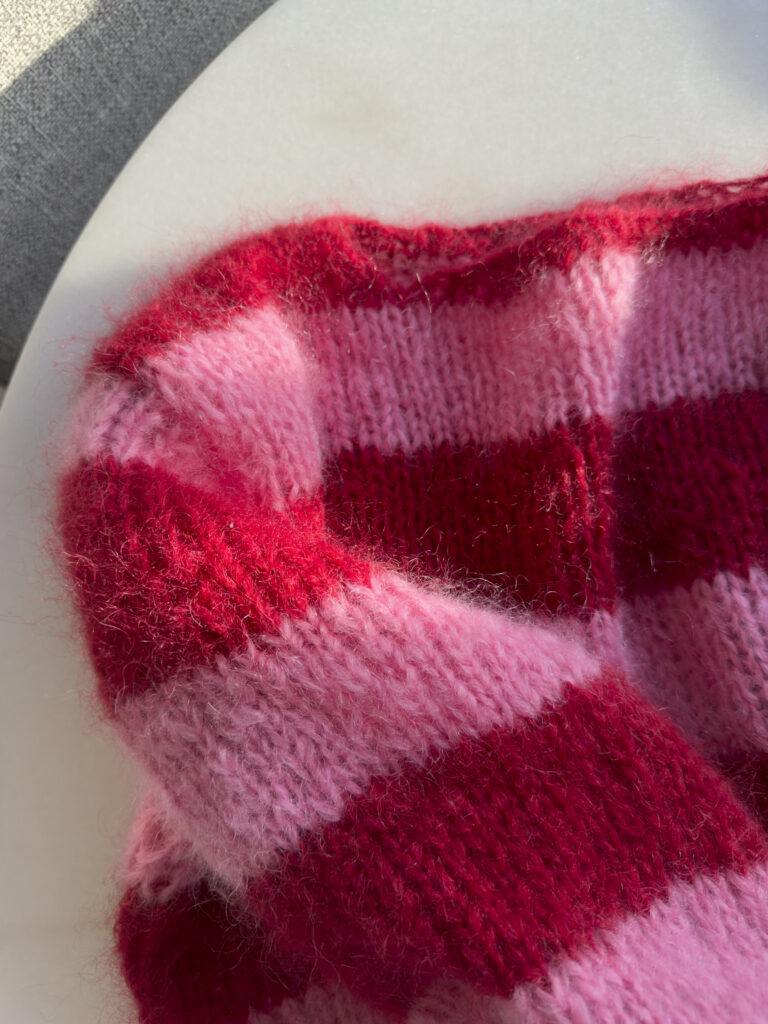
Nora’s cozy sweater mysize
If you want to add one more technique to your knitting skills, then I recommend this sweater. The sweater is knitted top down, which is great as you can try it on throughout the process and alter it accordingly. To make a slightly higher neck, the back panel is worked back and forth using German Short Rows, before you start increasing using raglan. German Short Rows (GSR) is a great technique to learn as it is used in many sweaters, and once you get the hang of it, it’s rather easy! Check out a tutorial on how to knit GSR in the Knit&Note app. Nora’s Cozy Sweater is oversized, and you can also choose to knit the body longer if you would like a longer fit. The bottom of the sleeve is knit with 4 rounds of purl to add a little cute detail to the sweater. This pattern is still beginner friendly and fun if you want a little extra challenge.
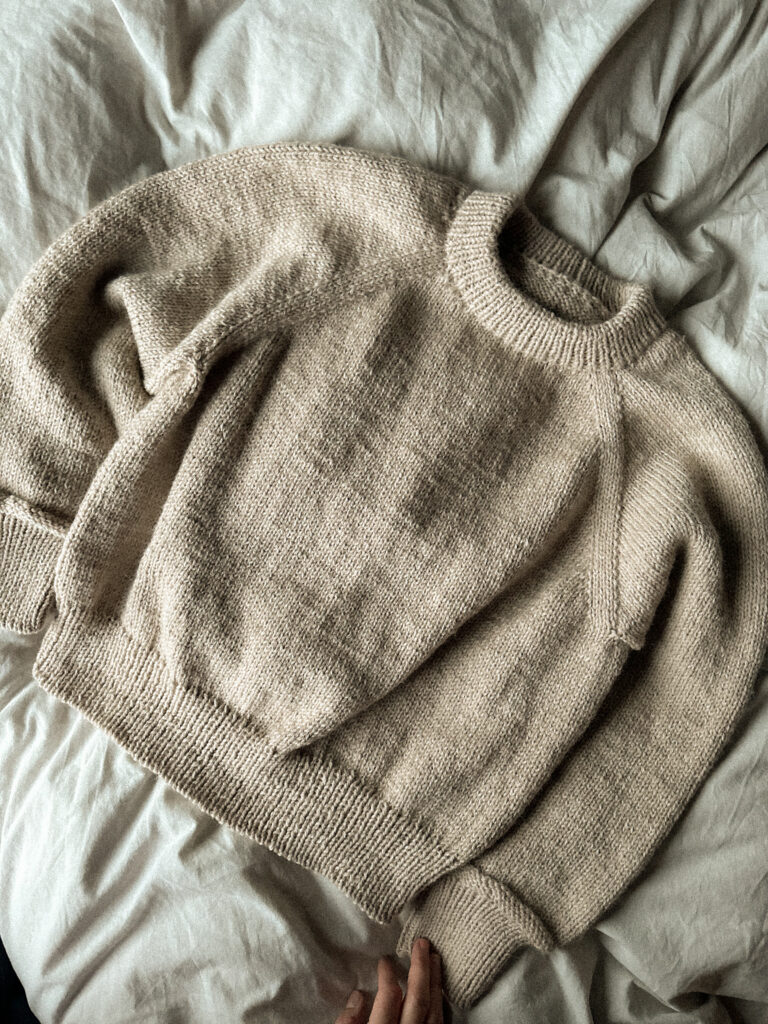
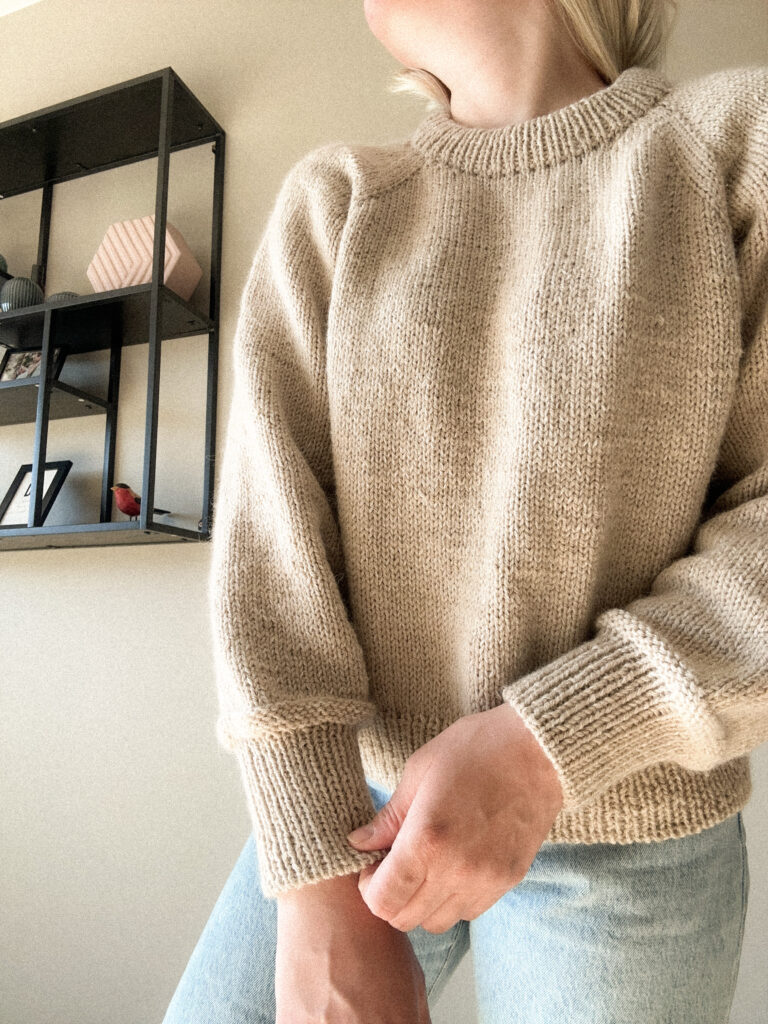
Chunky Sweater Knitting Patterns
Chunky sweaters are a favorite among knitters for their cute look and quick knitting time. Here are some characteristics of chunky sweater knitting patterns:
Big needles:
These patterns often use big needles, which helps knit up the sweater quickly, and creates a holey but breezy fabric.
Simple Shapes:
Chunky sweaters often feature simple shapes and minimal shaping, making them ideal for beginners.
Fun colors:
Because they’re quick projects it’s a great way to experiment with fun and snazzy colors, especially if it’s a light and fluffy sweater for the summer.
Tips for Choosing the Right Sweater Pattern
When selecting a sweater pattern, it’s important to consider the following factors to make sure that the project fits your needs and current skill level:
Skill Level:
Choose a pattern that matches your knitting skills. Beginners should look for patterns labeled “easy” or “beginner-friendly,” while more experienced knitters can explore intermediate and advanced patterns.
Yarn Availability:
Ensure you can easily source the recommended yarn or find a good suitable substitute. Check the yarn’s weight, fiber content, and gauge to match the pattern’s requirements.
Fit and Style:
Consider your body measurements and preferred fit. Look for patterns that offer different sizes and options for customization, such as adjusting the length of the body or sleeves.
Pattern Support:
Select patterns from reputable designers or publishers that offer clear instructions, charts, and support. The designers in the Knit&Note pattern library are handpicked by us, and we can vouch for great quality and gorgeous patterns.
Knitting a sweater is a fun, motivating and creative pastime that allows you to make your very own garment tailored to your style and preferences. By mastering basic techniques, choosing the right materials, and finding inspiration in various patterns, you can knit beautiful sweaters that you’ll have for years to come. Whether you’re knitting your first ever sweater or looking for new challenges, there’s always something new to learn and explore in the world of sweater knitting. Happy knitting!




